
(Additional content at flickr Photostream and YouTube Channel)
If you have botany questions or comments please email BobK . Thanks!
Twig features
useful in identification
BUDS
BUDS
Buds are embryonic branches or flowers in
a dormant state ready to resume growth when it gets warm again. The
buds of most species are protected by tough bud scales.
Bud scales can either be arranged in pairs facing each other
edgewise (valvate bud scales) or overlapping like shingles (imbricate
scales). A few species have naked buds that lack
scales and are protected instead by a pair of miniature leaves.


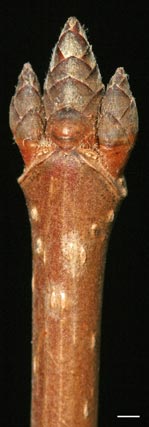
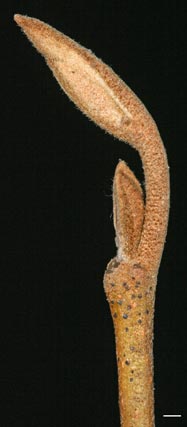
During the growing season lateral buds develop just above the point where the leaf rises off the stem. At the apex of a twig there may be a terminal bud that is larger than the laterals and points strictly forward. Some twigs lack a terminal bud, having instead a false terminal bud at the end of the twig which is actually the last-formed lateral bud. Alongside a false terminal bud look for the tip scar -- a remant of the sloughed-off portion of the branch tip that formerly extended past the bud. Oaks are noted for their clustered end buds that are actually lateral buds with very short internodes crowded towards the end of the twig.


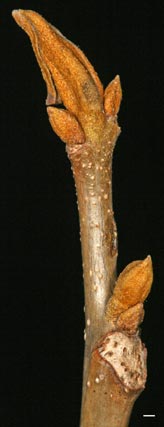

Bud examples (Left to Right): 1. Basswood (Tilia americana) lateral bud.
2. Basswood false terminal bud and tip scar.
3. Bitternut hickory (Carya cordiformis) with true terminal bud distinctly larger than laterals.
4. Clustered end buds of chinquapin oak (Quercus muhlenbergii).

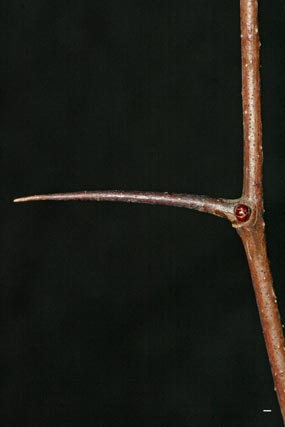
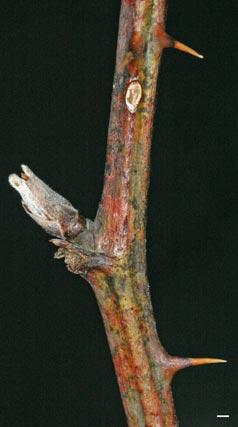
Plant surfaces usually lack hairs (i.e., are glabrous), so when we see ones that are pubescent (hairy), they stand out. Similarly, twigs may be smooth or have wing-like ridges, depending upin the species. The surface of the twig is often a good feature to distinguish otherwise similar species within a genus.
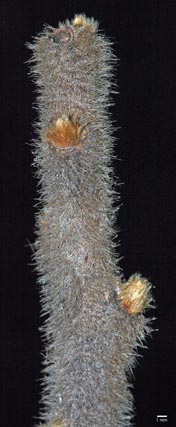



Twig surface examples (Left to Right): 1 and 2. Pubescent and glabrous twigs of staghorn sumac
(Rhus typhina) and smooth sumac (R. glabra), respectively. 3 and 4. Winged and smooth twigs of blue ash (Fraxinus quadrangulata) and green ash (F. pennsylvanica) respectively).




Bud scale examples (left to right): 1.
Flower bud, cross-section, of horse-chestnut (Aesculus
hippocastanum) showing bud scales. 2. Valvate bud scales of
tulip-tree (Liriodendron tulipifera). 3. Imbricate bud scales of
sugar maple (Acer saccharum). 4. Naked buds of witch-hazel (Hamammelis
virginiana).
During the growing season lateral buds develop just above the point where the leaf rises off the stem. At the apex of a twig there may be a terminal bud that is larger than the laterals and points strictly forward. Some twigs lack a terminal bud, having instead a false terminal bud at the end of the twig which is actually the last-formed lateral bud. Alongside a false terminal bud look for the tip scar -- a remant of the sloughed-off portion of the branch tip that formerly extended past the bud. Oaks are noted for their clustered end buds that are actually lateral buds with very short internodes crowded towards the end of the twig.




Bud examples (Left to Right): 1. Basswood (Tilia americana) lateral bud.
2. Basswood false terminal bud and tip scar.
3. Bitternut hickory (Carya cordiformis) with true terminal bud distinctly larger than laterals.
4. Clustered end buds of chinquapin oak (Quercus muhlenbergii).
Leaf (bud) Arrangement
The point along a branch where a leaf
is attached is called a node.
"Phylotaxy" is a descriptive scheme that describes the precise manner
in which leaves are arranged on a branch. The simplest set of phylotaxy
descriptors calls attention to the number of leaves (and accordingly
the axillary buds) per node.There are three types of leaf (bud)
arrangement, of which the most common is alternate,
i.e., one leaf (bud) per node. Less frequent but by no means rare
are species having two opposite leaves (buds) per node. A very
few plants have whorled leaves (buds), with three or more at
each node. Sub-opposite
buds are morphologically alternate, but they are have such a small
length of twig (internode) between them that they practically
appear opposite.

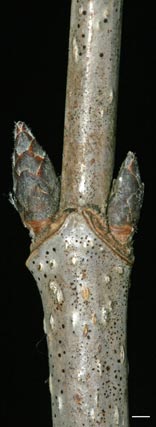


Leaf arrangement examples (Left to Right): 1. Alternate (bald-cypress, Taxodium distichum).
2. Opposite (elderberry, Sambucus canadensis). 3. Whorled (showy catalpa, Catalpa speciosa).
4. Sub-opposite (common buckthorn, Rhamnus cathartica).
Leaf scars and their bundle scars, Bud-scale scars, Fruit scars




Leaf arrangement examples (Left to Right): 1. Alternate (bald-cypress, Taxodium distichum).
2. Opposite (elderberry, Sambucus canadensis). 3. Whorled (showy catalpa, Catalpa speciosa).
4. Sub-opposite (common buckthorn, Rhamnus cathartica).
Leaf scars and their bundle scars, Bud-scale scars, Fruit scars
When a leaf falls from a branch at the end
of the growing season, a rough patch reamins under its base, the leaf
scar, within which there are one or more bundle scars --remnants
of the "plumbing" (vascular system) connection that extended
between the veins of the
leaf and the branch. Leaf scars come in many distinctive
shapes and sizes, and the number and distribution of bundle scars is
distinctive, too.
A useful feature to determine the age of a twig (or how much growth occurred in one season) is an array of several narrow, crowded, bud scale scars left where the scales fell from a true terminal bud at the initiation of the growing season. When fruits fall off a tree, sometimes they leave a fruit scar.
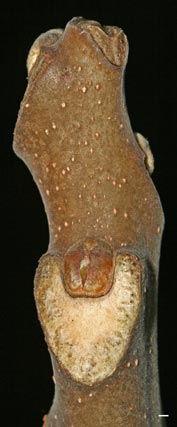


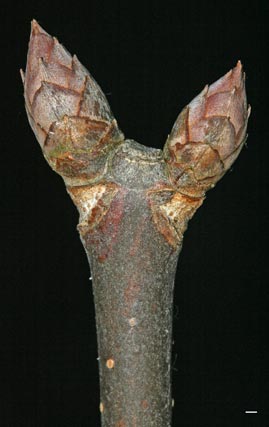
A useful feature to determine the age of a twig (or how much growth occurred in one season) is an array of several narrow, crowded, bud scale scars left where the scales fell from a true terminal bud at the initiation of the growing season. When fruits fall off a tree, sometimes they leave a fruit scar.




Various scar examples (Left to Right): 1.
Large shield-shaped leaf scar of tree-of-heaven (Ailanthus altissima)
with U-shaped arrangement of numerous indistinct bundle scars. 2.
Eliptical leaf scar of sweetgum (Liquidambar styraciflua)
with three distinct bundle scars. 3. Bud scale scars marking the end of
one year's growth and the beginning of another on red ash (Fraxinus
pennsylvanica). 4. Buckeye (Aesculus glabra) fruit scar.
...and stipule scars
Some leaves have stipules: little
leaf-like apendages at base of the leafstalk, where it joins the
stem.
Because they're attached to the twig, stipules, when they are shed, may
leave a stipule scar.
In a few species the stipule scars are very prominent, wrapping
entirely around the stem. (Other plants have shorter stipule
scars, occurring as short lines
extensing down from the corners of the leaf scar.)
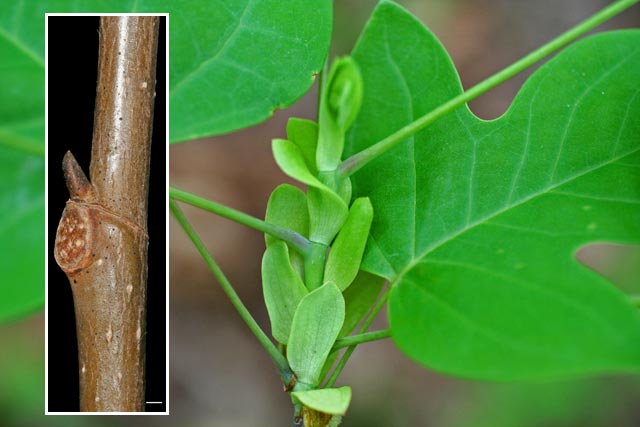

Tulip-tree (Liriodendron tulipifera)
stipules, Wayne National Forest, Vinton Cty., OH, May 21, 2006,
and (inset) twig showing stipule scar completely encirlcling the twig.
and (inset) twig showing stipule scar completely encirlcling the twig.
Ouch! (spines, thorns, and prickles)
Although they both hurt when you grab them (or if you are a
deer, when you try to eat twigs that have them) there are slight
anatomical differences between the various types of plant armature. Spines
are modified leaves or stipules and as such are generally thinner and
shorter than thorns, which are modified branches. Prickles
are slender outgrowths of the epidermis. 


Armature examples (Left to Right): 1.
Stipular spines of blacklocust (Robinia pseudoacacia).
2. Thorn of hawthorn (Crataegus
crusgallii). 3. Raspberry (Rubus allegheniensis) prickle.
...and other surface features
Plant surfaces usually lack hairs (i.e., are glabrous), so when we see ones that are pubescent (hairy), they stand out. Similarly, twigs may be smooth or have wing-like ridges, depending upin the species. The surface of the twig is often a good feature to distinguish otherwise similar species within a genus.




Twig surface examples (Left to Right): 1 and 2. Pubescent and glabrous twigs of staghorn sumac
(Rhus typhina) and smooth sumac (R. glabra), respectively. 3 and 4. Winged and smooth twigs of blue ash (Fraxinus quadrangulata) and green ash (F. pennsylvanica) respectively).
Pith
The central cylinder of a twig --the pith
--
is composed of non-woody tissue having a markedly different texture
than the surrounding remainder of the twig. Viewed in a longitudinal
section made with a razor blade or sharp knife, there are several
potentially distinctive aspects of pith. Most species have pith that is
fairly unremarkable: smooth without any interuptions, called
continuous homogenous pith. More interesting pith has
cross walls (partitions). If these partitions occur additional
to continuous material in the center of the twig the pith is said
to be diaphragmed, whereas if the partitions occur in an
otherwise hollow space the pith is chambered. A few
species lack pith altogether.








Pith examples (Left to Right):
Continuous homogenous pith of tree-of-heaven (Ailanthus altissima).
2. Diaphragmed pith of tulip-tree (Liriodendron
tulipifera).
3. Chambered pith of black walnut (Juglans
nigra). 4. Hollow (no) pith of honeysuckle (Lonicera
sp.).

